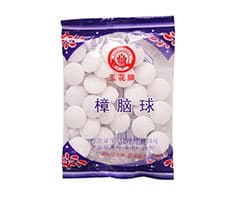 Naphthalene is naphthalene that is used to disinfect and combat moths . The term comes from the French word naphtaline . Naphthalene, on the other hand, is the aromatic hydrocarbon resulting from the condensation of a pair of benzene rings.
Naphthalene is naphthalene that is used to disinfect and combat moths . The term comes from the French word naphtaline . Naphthalene, on the other hand, is the aromatic hydrocarbon resulting from the condensation of a pair of benzene rings.
Naphthalene is generally obtained from coal tar . In any case, it is also possible to obtain it during oil refining and through other processes.
The most common mechanism consists of distilling coal tar to obtain an oil with about 50% naphthalene. Said oil is then washed and distilled in order to produce the isolation of crude naphthalene.
With a characteristic odor, mothballs are usually sold as small white balls . This product, which should not be handled directly due to its toxicity, is for domestic use as a repellent for moths, insects that usually attack different types of fabrics.
Beyond its usefulness, it is important to keep in mind that naphthalene, because it is toxic , can cause serious damage to health . When a person is poisoned by mothballs, the substance affects their red blood cells, which become unable to transport oxygen. This, in turn, can cause organ damage.
Pain in the abdominal area, headache, nausea, vomiting, diarrhea and breathing difficulties are some of the symptoms of mothball poisoning , which can also include drowsiness, confusion and tachycardia. In these cases, it is necessary to go to a hospital urgently.
It should be noted that the smell of mothballs is associated with that which smells old or old . This is due to the habit , very common decades ago, of placing mothballs in closets to protect clothing that was not frequently worn. That is why today, if it is stated that something smells like mothballs, it is being pointed out as old or archaic.
 Due to its toxicity and the smell it leaves on clothes and closets, many people look for alternatives to mothballs. And, although it is a product that is still being marketed today, there are other ways to combat moths that are much more enjoyable, respectful of the environment and that do not expose us to any risk of poisoning.
Due to its toxicity and the smell it leaves on clothes and closets, many people look for alternatives to mothballs. And, although it is a product that is still being marketed today, there are other ways to combat moths that are much more enjoyable, respectful of the environment and that do not expose us to any risk of poisoning.
The aromatic cycles of mothballs do not degrade easily, and on top of that the small pellets represent a danger to children and pets, who often ingest them by accident or put them in their mouths and nostrils. If a minor comes into contact with mothballs excessively, they can suffer even worse consequences than an adult, such as neurological damage.
In this framework, cedar wood is an excellent alternative to mothballs. It is also sold in pellets, whose strong aroma effectively repels moths. Some packages include a small bottle of cedarwood essential oil to soak before use. It is advisable to place them in a cotton bag and wait for them to dry to prevent them from staining the clothes.
A cheaper and easier to obtain product is lemon or orange peel , which should be left in the sun until it dries, then placed in a cotton bag and hung in the closet. Lavender leaves have a similar effect : we must dry a few branches, and make a powder with the leaves before we can use them. Similarly, black pepper is another insect repellent: crack a few grains and that's it. Needless to say, pepper can irritate the eyes.
